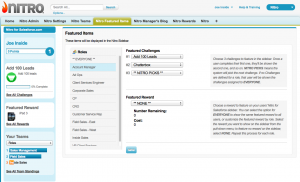One of the things companies most want to accomplish with gamification is to offer scalable personalization. In an ideal world, e-commerce, social and behavior-change sites would offer entirely personalized views of game mechanics like challenges, achievements, leaderboards, etc. Just as targeted advertising has helped raise click-through rates, so too would personalized gamification be better able to match consumer to concept, player to game mechanic.
Bunchball took a major step forward down this path this week with the release of their Nitro 4.3 platform, called Flamethrower. In addition to all-new HTML5 widgets and Omniture integration, the centerpiece of this release is their personalization features. In a nutshell, personalization in Nitro allows sites and apps to inject (automatically or manually) additional fields into every user’s profile. These fields (currently limited to three, but growth is on the roadmap) can hold an unlimited number of arguments, and can be used to dynamically alter the views of the user’s gamification stream.

For example, if you know that a user has previously purchased a big-ticket item (say, a motorcycle) from your site, you can make challenges or mini-games that are relevant to them appear. Or you could upload demographic data to constrain the kind of individual items that are presented in virtual goods. Pretty cool and powerful stuff.
As with most advanced gamification features, much of the devil is in the details. While I don’t think the three field limit is a major constraint in the near term (there are still hundreds of thousands of possible trigger combos), it’s clearly something the company must evolve. Moreover, the holy grail of personalized gamification really lies in the ability of the system (or its administrators) to create more dynamic paths for users to take based on past behavior. For example, as the system learns that 45 year old Harley buyers tend to prefer poker-style gamified experiences, ideally their experience should simply change to reflect this preference.
That kind of artificial intelligence in gamification may be a ways off, but it’s likely to have a huge impact on outcomes. This is a welcome first step.

There’s also the added context of their deepened relationship with Jive, announced this week. We first covered BunchBall and Jive some months ago, and it seems they are now going to embed and resell Nitro as part of the Jive platform. This kind of innovation in the platform and enterprise space is great news for the Gamification industry. The robust competition from key players like BunchBall, Badgeville and BigDoor has helped propel the industry forward at a shocking pace. By 2015, M2 forecasts over $2.5Bn US spending on gamification products and services, and tens of thousands of organizations using the techniques can do so at scale because of the availability of these platforms.
What you do with them however, remains entirely up to you.
With all the added power of these platforms, getting an accredited gamification design education is more important than ever. Join a certification workshop at GSummit 2012 and go hands on with me (Gabe Zichermann) or Mario Herger for a full-day workshop that will teach you how to design gamified experiences for your site, app or organization. You’ll also see the essentials of how to use major gamification platforms, and earn your certificate in gamification design.








I think I’m going to have to take a closer look at this.